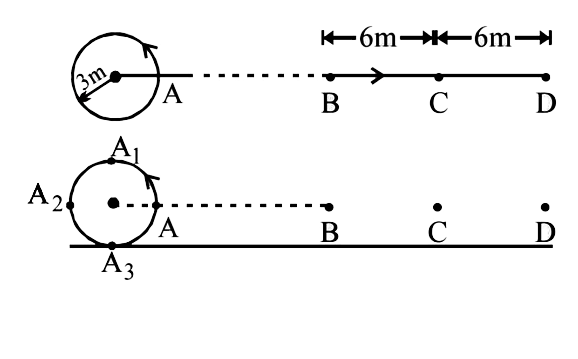Statement I: waves genrated in a metal piece can be transverse or longitudinal.
statement II: waves generated depend upon the method of creating waves in the metel.Solution in Gujrati
Statement-1 is true, Statement-2 is true , Statement-2 is correct explanation for Statement-15
Statement-1 is true,Statement-2 is true , Statement-2 is NOT a correct explanation for Statement-15
Statement-1 is true, Statement-2 is false
Statement-1 is false, Statement-2 is true
The correct Answer is:A
Step by step video & image solution for Statement I: waves genrated in a metal piece can be transverse or longitudinal. statement II: waves generated depend upon the method of creating waves in the metel. by Physics experts to help you in doubts & scoring excellent marks in Class 11 exams.
Updated on:21/07/2023Topper's Solved these Questions
- WAVES AND OSCILLATIONSBOOK - ALLEN CHAPTER - WAVES AND OSCILLATIONSEXERCISE - Part-1(Exercise-04)[A]
29 Videos
- WAVES AND OSCILLATIONSBOOK - ALLEN CHAPTER - WAVES AND OSCILLATIONSEXERCISE - Part-1(Exercise-04)[B]
13 Videos
- WAVES AND OSCILLATIONSBOOK - ALLEN CHAPTER - WAVES AND OSCILLATIONSEXERCISE - Part-1(Exercise-02)
19 Videos
- SEMICONDUCTORSBOOK - ALLEN CHAPTER - SEMICONDUCTORSEXERCISE - Part-3(Exercise-4)
50 Videos
Similar Questions
A stone dropped from the top of a tower of height 300 m high splashes into the water of a pond near the base of the tower. When is the splash heard at the top givne that the speed of sound in air is 340ms−1?(g=9.8ms−2)
View SolutionA source of sound is moving along a circular orbit of radius 3meter with an angular velocity of 10rad/s. A sound detector located far away from the source is executing linear simple harmonic motion along the line BD with an amplitude BC=CD=6meters. The frequency of oscillation of the detector is 5π per second. The source is at the point A when the detector is at the point B. If the source emits a continuous sound wave of frequency 340Hz, Find the maximum and the minimum frequencies recorded by the detector.

View SolutionA sound wave of frequency f travels horizontally to the right. It is reflected from a large vertical plane surface moving to left with a speed v. The speed of sound in medium is C
View SolutionAt absolute zero temperature Si acts as ……..
View SolutionStatement I : The pitch of the sound wave depends upon its frequency.
Statement II: The loudness of the sound wave depends upon its amplitude.
View Solutionकिसी चट्टान (rock) में उत्पन्न (i) अनुप्रस्थ यांत्रिक तरंग (S-तरंग) (ii) अनुदैर्ध्य यांत्रिक तरंग (P-तरंग) की चाल के सूत्र लिखिये।
View Solutionकौन-सी तरंगें अनुप्रस्थ तरंगें हैं तथा कौन-सी तरंगें अनुदैर्ध्य?
View Solutionनिम्नलिखित में से अनुप्रस्थ तथा अनुदैर्ध्य तरंगें छाँटिए :
(i) स्प्रिंग में उत्पन्न तरंगें
(ii) तने तार में उत्पन्न तरंगें
(iii) जल के ताल पर उत्पन्न तरंगें
(iv) वायु में उत्पन्न तरंगें।
View SolutionStatement I: Electromagnetic waves are transverse waves. Statement II: Electromagnetic waves have the property of polarization.
View SolutionWhat are longitudinal waves and transverse waves ?
View SolutionStatement-I : Light waves can be polarised. Statement-II: It is because light waves are transverse in nature.
View SolutionWhich of the following statements are correct ?
(i) Light waves can be polarised
(ii) Longitudinal waves cannot be polarised
(iii) Sound waves in gas can be polarised
(iv) Transverse waves in a string can be polarised
View SolutionWhich of the following statements are correct ?
(i) Light waves can be polarised
(ii) Longitudinal waves cannot be polarised
(iii) Sound waves in gas can be polarised
(iv) Transverse waves in a string can be polarised
View SolutionWaves | Introduction, Transverse & Longitudinal Waves
View SolutionWhat are longitudinal waves and transverse waves ?
View Solutionवक्तव्य I प्रकाश एक अनुप्रस्थ तरंग है लेकिन विद्युतचुम्बकीय तरंग नहीं है।
वक्तव्य II मैक्सवेल ने ये प्रदर्शित किया कि विद्युतचुम्बकीय तरंगों का वेग माध्यम के परावैद्युतांक व पारगम्यता पर निर्भर करता है।
View Solution
